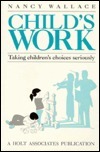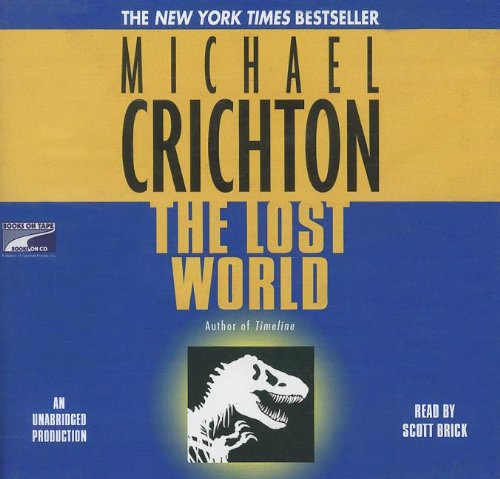Ji FU rated Child's Work: 4 stars

Child's Work by Nancy Wallace
What happens when children are allowed to spend their growing years doing what they want to do rather than what …
Trying to find a better way to track books I want to read than a random spreadsheet. I had used readinglog.info which was provided by my local public library until they shut down the program. Luckily, I regularly backed it up via their CSV export. I've used Library Thing for years, but adding books for "To Read" really screwed up a lot of the other features of the website, like recommendations, etc. I really love Free Software & the Fediverse particularly. My primary social media account is on Friendica @fu@libranet.de
This link opens in a pop-up window

What happens when children are allowed to spend their growing years doing what they want to do rather than what …
This work was well written. I would say I liked it three stars. Definitely left me feeling uneasy, and honestly quite hopeless. In part I think that is what the author was going for. A speculative fiction work based in a North American society that has taken Calvinist fundamentalism to the extreme. Including, but not limited to, forbidding "baren" wives from fornicating with their husbands, instead forcing a "hand maid' to move in in which they have a breeding ceremony once a month to try to impregnate her with everyone watching. Its been said that when Atwood only put things in here that already existed somewhere in the world in 1980s. Maybe in Iran? I'm not sure. Seems far-fetched even for such repressive regimes. I was disappointed that the story kind of just ended. Nothing resolved, and it certainly wasn't happy (or maybe it was, we really don't know). The …
This work was well written. I would say I liked it three stars. Definitely left me feeling uneasy, and honestly quite hopeless. In part I think that is what the author was going for. A speculative fiction work based in a North American society that has taken Calvinist fundamentalism to the extreme. Including, but not limited to, forbidding "baren" wives from fornicating with their husbands, instead forcing a "hand maid' to move in in which they have a breeding ceremony once a month to try to impregnate her with everyone watching. Its been said that when Atwood only put things in here that already existed somewhere in the world in 1980s. Maybe in Iran? I'm not sure. Seems far-fetched even for such repressive regimes. I was disappointed that the story kind of just ended. Nothing resolved, and it certainly wasn't happy (or maybe it was, we really don't know). The author did TRY to add a little with a summary of a future historian looking back on this as if it were a collection of historical events.

The Handmaid's Tale is a radical departure for Margaret Atwood. Set in the near future, in a locale that oddly …
On hold at the public library. I've been actively looking forward to this one from several years now, I hope it delivers.
On hold at the public library. I've been actively looking forward to this one from several years now, I hope it delivers.

The Lost World revisits the Central American site of the Jurassic Park fiasco. It has been six years since the …
A fantastic tale of Mister Rogers. I figured it would probably be a fluff piece about how we should be kind to each other and not preach religion. I was glad to learn I was wrong. Amy Hollingsworth is a preacher's wife, raised Catholic, but her husband is a Protestant (Pentacostal I think but I haven't been able to confirm that) pastor.
Mister Rogers was an ordained Presbyterian minister. His parents assumed he'd go to seminary, so he did, but was called by God to children's television and not the pulpit. He tried to the get the American Presbyterian Church to ordain him a pastor without a parish and assign him to children's television, possibly producing content for the denomination's Sunday Schools, but they did not. Eventually he did finish his studies whilst working on Mister Rogers Neighborhood, but he never did pastor a congregation.
I really appreciated …
A fantastic tale of Mister Rogers. I figured it would probably be a fluff piece about how we should be kind to each other and not preach religion. I was glad to learn I was wrong. Amy Hollingsworth is a preacher's wife, raised Catholic, but her husband is a Protestant (Pentacostal I think but I haven't been able to confirm that) pastor.
Mister Rogers was an ordained Presbyterian minister. His parents assumed he'd go to seminary, so he did, but was called by God to children's television and not the pulpit. He tried to the get the American Presbyterian Church to ordain him a pastor without a parish and assign him to children's television, possibly producing content for the denomination's Sunday Schools, but they did not. Eventually he did finish his studies whilst working on Mister Rogers Neighborhood, but he never did pastor a congregation.
I really appreciated how Fred Rogers was able to over the course of like three years of correspondence with Hollingsworth really show love to her and really introduce Christ to her in a way that even a Cradle Catholic Preacher's wife hadn't known.
I've heard the story of seeing people hit in the face with pies on T.V. leading Fred to feel he had to get involved to ensure such a powerful medium was used for betterment of humankind, and not such demeaningness. However I was most touched by his description of the Holy Spirit working between the T.V. and the television neighbor to comfort them and tell them exactly what they needed to hear. More than once, he described a way a viewer, kid or parent, described how when he said such-and-such on such-and-such episode and how it changed their life, yet he wouldn't remember ever having said that, and went back and verified it was never in the script, but God found a way regardless.
I highly recommend this book, particularly to believers in a time when many in The West are lost, both in and out of the Church.
I wanted to read this book for a long time. It sounds awesome, a kid born right at midnight as newly partitioned India officially is declared independent of Britian, and he eventually learns he has magic abilities that include the ability to communicate telepathically with all other kids that were born in the first hour since the country's birth.
It, however, is not good. I find nothing redeeming about this story. Nothing happens in the entire first section of the book, to the point the protagonist's wife even goes about interrupting the story asking him to get to the good part. It's kind of meta, but not in the fun way. When we got to section II it kept feeling like it was just about to get good, just enough to keep my reading. Yet, nothing ever came interesting. I read some 400 pages before I gave up on …
I wanted to read this book for a long time. It sounds awesome, a kid born right at midnight as newly partitioned India officially is declared independent of Britian, and he eventually learns he has magic abilities that include the ability to communicate telepathically with all other kids that were born in the first hour since the country's birth.
It, however, is not good. I find nothing redeeming about this story. Nothing happens in the entire first section of the book, to the point the protagonist's wife even goes about interrupting the story asking him to get to the good part. It's kind of meta, but not in the fun way. When we got to section II it kept feeling like it was just about to get good, just enough to keep my reading. Yet, nothing ever came interesting. I read some 400 pages before I gave up on it.
If you do choose to read this for some reason I highly recommend skipping Part I.
I'm not really quite sure what I thought this book was going to be. The intorduction was really good and I think is closer to what I was expecting, more of a story/history about Yiddish in the U.S. He speaks of how most linguists harrumph at the use of Yiddish in the States as an accent to the primary language, and with most Jews now living in either the U.S. or Isreal (where Hebrew, not Yiddish, is the default tongue) Yiddish as a language is dying. But the author thinks the way it has worked its way into the general lexicon is actually great. After the intro it becomes, more-or-less, a dictionary of Yiddish words that are heard in American (what the author calls Ameridish or Yinglish) and what they mean, occasionally with a history of its use, either in the old world or the new, and often with a …
I'm not really quite sure what I thought this book was going to be. The intorduction was really good and I think is closer to what I was expecting, more of a story/history about Yiddish in the U.S. He speaks of how most linguists harrumph at the use of Yiddish in the States as an accent to the primary language, and with most Jews now living in either the U.S. or Isreal (where Hebrew, not Yiddish, is the default tongue) Yiddish as a language is dying. But the author thinks the way it has worked its way into the general lexicon is actually great. After the intro it becomes, more-or-less, a dictionary of Yiddish words that are heard in American (what the author calls Ameridish or Yinglish) and what they mean, occasionally with a history of its use, either in the old world or the new, and often with a story, that claims to be numerous, about its use. Very dry, not that funny. Eventually I stopped reading each one and just skimmed ahead to words I've actually used or heard others use.
I keep seeing posts on the 'verse that this is what "they" want to happen, so I figured I should read it so I have any idea what the other netizens are talking about.
I keep seeing posts on the 'verse that this is what "they" want to happen, so I figured I should read it so I have any idea what the other netizens are talking about.
I had to stop "reading" it. All the descriptions of blood and stuff got me queasy. I don't know why so many authors feel it's necessary to go into detail on this stuff. I kept trying to resume and I just couldn't. With a paper book I could just skim and skip over it if there isn't too much, but that's a lot more difficult in audiobook format.
I had to stop "reading" it. All the descriptions of blood and stuff got me queasy. I don't know why so many authors feel it's necessary to go into detail on this stuff. I kept trying to resume and I just couldn't. With a paper book I could just skim and skip over it if there isn't too much, but that's a lot more difficult in audiobook format.
Bill Homewood's voice was so annoying that I quit reading this after the first CD. I'll try to find another copy.
Bill Homewood's voice was so annoying that I quit reading this after the first CD. I'll try to find another copy.

The Lost World is a 1995 techno-thriller novel written by Michael Crichton, and the sequel to his 1990 novel Jurassic …